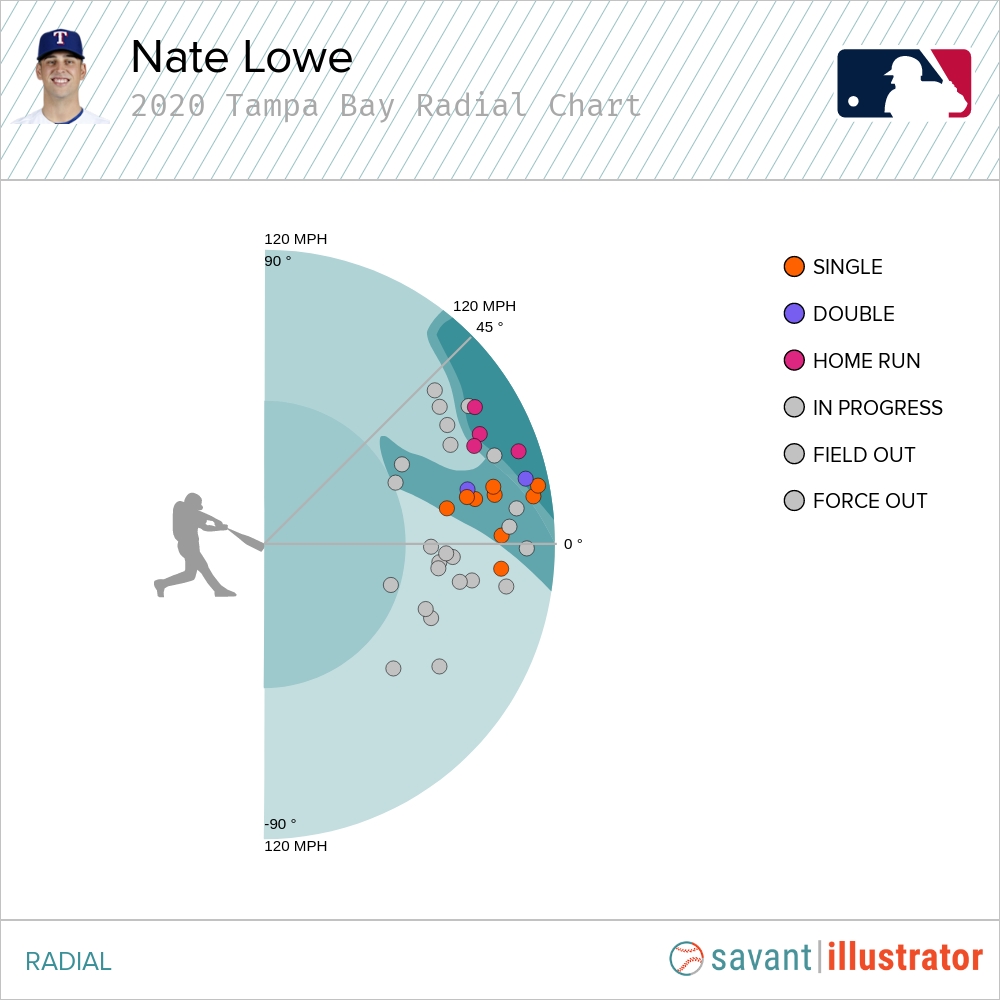After only playing in 71 games over the past two years for the club that originally drafted him in the 13th round in 2016, the Tampa Bay Rays this offseason traded Nate Lowe to the Rangers in a deal that was an exchange of a potpourri of assets. For the Rangers, after four straight losing seasons and the hiring of Chris Young to be their GM, a rebuild seemed imminent, and Lowe is the kind of buy-low asset who could thrive in a low-pressure environment.
As for Lowe, he was the odd man out at first in Tampa Bay last year, as the Rays favored the platoon of Ji-Man Choi and Yandy Diaz at the position, and unfortunately, there were not a lot of other places in the field or lineup for Lowe to find time or at-bats.
However, the move to the Lone Star State has seemed to benefit Lowe, at least according to the early returns.
Going into Wednesday’s games, Lowe is posting a .381/.409./.857 slash with three home runs and 14 RBI in 22 plate appearances. After being ranked 1,642 in Yahoo’s preseason rankings, Lowe, going into Wednesday, ranked fourth overall, a sign that he has surpassed not only the expectations of Rangers fans thus far into the season, but also fantasy owners as well.
Thus, has Lowe found a home in Texas and is primed for a major breakout in 2021? Or is this sample size just a hot start, and will Lowe fizzle out at some point this season?
More Aggressive Approach = More Hard Hits, Production
In 2020 with the Rays, Lowe only posted a slash of .224/.316/.433 in 76 plate appearances during the shortened COVID season. While he did hit four home runs, he saw his exit velocity on batted balls drop from 91.3 mph in 2019 to 88.9 mph in 2020. Furthermore, his launch angle also decreased, not a good sign for a hitter who relies on his power for production at the plate. Lowe’s average launch angle went from 13 degrees in 2019 to 7.1 degrees, according to Savant. Thus, it’s not surprising that Lowe saw some regression in many of his key hitting categories, as well as a radial chart that is littered with too many low-angle groundballs:

However, two interesting trends emerged from Lowe’s 2019 metrics: 1.) his barrel rate actually increased from 10.6 percent in 2019 to 15.4 percent in 2020, and 2.) his Max EV not only increased by 0.5 points (to 114.8 mph) but also ranked in the top three percent of the league.
What does this mean?
Well, it signifies that while Lowe may not have been as consistently productive when it came to hitting the ball hard, he still demonstrated that he could mash when everything clicked. Unfortunately, he just did not have enough opportunities last year in Tampa to see those “small” glimpses of power production blossom into something more over the long term.
Also, it seemed like Lowe transitioned to a more patient approach in 2020, and I’m not sure if that helped him at the plate overall.
Granted, Lowe did see an increase in walk rate, as it rose from 7.6 to 11.8 percent from 2019 to 2020, respectively. However, he also increased his strikeout rate from 30 percent in 2019 to 36.8 percent in 2020. Thus, Lowe did not just become more patient at the plate, but he also became more “passive” as well. This passivity last year is also evident in his “meatball swing” percentage, which went from 72.5 percent in 2019 to 55 percent in 2020.
For a guy with such prodigious power, letting go of that many good balls to hit is not encouraging, especially for a player who had so much competition around him in Tampa last season. Perhaps Lowe was pressing due to that competition. Perhaps he was trying a new hitting approach with the Rays hitting instructors, and he was experiencing an adjustment to that new approach. Either way, his plate approach didn’t suit him last year, and it showed in his overall production.
However, since moving to Texas, Lowe has demonstrated a more “swing-happy” approach. His walk rate has decreased from 11.8 to 4.5 percent from 2020 to 2021. Furthermore, he also increased his chase rate from 20.4 percent to 27.8 percent from 2020 to 2021. That being said, all his power metrics have skyrocketed with this new aggressive approach.
Going into Wednesday, he ranks in the top six percent of the league in barrel rate. He ranks in the top eight percent of the league in exit velocity. His launch angle is 14.2 degrees, the highest of his career thus far. His wOBA is .530, which puts him in the top seven percent of the league. And lastly, his “meatball swing” percentage this season 83.3 percent this season, a dramatic turnaround from last season.
The Rangers coaching staff is letting Lowe swing away … and so far this year, that mindset has helped not only Lowe, but the Rangers offense overall as well, especially as Lowe has been a perfect partner with Joey Gallo in the heart of the lineup.
Fastballs, Breaking Balls, and Sustainability
What has been an interesting trend for Lowe over this hot start has been his improvement against fastball from a year ago. Let’s take a look at Lowe’s metrics from 2019 to this season in regard to how he has fared against fastballs:
| Year | % | WOBA | XWOBA | EV | LA | Whiff% | PutAway% |
|---|---|---|---|---|---|---|---|
| 2021 | 55 | 0.399 | 0.298 | 92 | 15 | 34.6 | 46.2 |
| 2020 | 70.5 | 0.214 | 0.274 | 88.3 | 12 | 32.1 | 36.8 |
| 2019 | 58.1 | 0.351 | 0.353 | 91.9 | 11 | 30.6 | 24.6 |
Granted, the metrics have some concerning signs. Even though he has seen fewer fastballs this year (55 percent in comparison to 70.5 percent last year), he has whiffed more against fastballs and been put away on the pitch more than in 2019 and 2020. However, his exit velocity and launch angle on batted balls against fastball have improved, and thus, it’s not surprising that he’s experienced a 155 point increase in wOBA on fastballs so far in 2021.
Now, there is a 100 point difference between wOBA and xwOBA in favor of wOBA, which is a sign that possible regression may be in store for Lowe. That being said, if Lowe can be somewhere between his current performance and his 2019 line against the fastball, then that may be enough to keep him productive and as a viable fantasy option. He just needs to avoid those 2020 lows, and judging by his xwOBA, this hot start may be a sign of Lowe’s metrics correcting themselves a little bit from last season, especially with a little bit more playing time and at-bats.
Another reason that Lowe could experience some regression on the fastball after his hot start and still be productive is that he has a solid history against breaking balls, especially from last season. Let’s take a look at his three-year metrics against breaking pitches, courtesy of Savant.
| Year | % | WOBA | XWOBA | EV | LA | Whiff% | PutAway% |
|---|---|---|---|---|---|---|---|
| 2021 | 35 | 0.811 | 0.766 | 106.8 | 12 | 25 | 66.7 |
| 2020 | 18.6 | 0.519 | 0.405 | 96.9 | 9 | 30.4 | 21.7 |
| 2019 | 29.1 | 0.272 | 0.266 | 89.6 | 20 | 27.5 | 23 |
After posting a .272 wOBA and 89.6 mph exit velocity on breaking pitches in 2019, Lowe absolutely mashed breaking balls in 2020. Even though he only saw the pitch 18.6 percent of the time, he posted a .519 wOBA on the pitch and also increased his exit velocity by 3.3 mph. Granted, he did whiff more, but he also produced bombs like this one against the Mets’ Jacob deGrom last season:
https://gfycat.com/advancedsimilardungenesscrab
Lowe has seen an uptick in breaking balls this season, but he’s been even better against them, even though he’s seen the pitch 35 percent of the time, nearly double the amount he saw in 2020.
Currently, he’s posting a .831 wOBA against breaking pitches, and he’s increased his exit velocity on batted balls on the pitch by 9.9 mph. Furthermore, he’s whiffing less on the pitch, as he is down not only 5.4 percent from his 2020, but even 2.5 percent from 2019, when his metrics against breaking pitches were pretty mediocre overall.
Additionally, Lowe’s ability against the pitch is obvious when watching him live, as evidenced by him crushing a similar pitch from the Royals’ Brady Singer on Easter Sunday, which is around the zone of the deGrom pitch from 2020:
Nate Lowe hit one to the second deck of the fountain 😳 pic.twitter.com/5zvpVKwLkO
— MLB (@MLB) April 4, 2021
Now, a .831 wOBA against breaking pitches will be hard to sustain over the long haul. It is also likely that the amount of those pitches he will see will also regress, especially considering his success against it the past two years. That being said, Lowe may be able to sustain his productive performance over the long haul of 2021 if he can continue to show gains against fastballs this season. His ability to read and mash breaking balls seems to be a pretty solid skill, and if he can at least be around his 2019 metrics, or even slightly below, against fastballs, then it is possible that Lowe could be one of more dangerous “dark horse” hitters in baseball this season.
Lowe’s Outlook in 2021
Lowe is in a good spot in the lineup, as he is batting fourth in the Rangers lineup behind David Dahl, who is having a bounce-back himself after a rough final season in Colorado, and Joey Gallo, who is one of the most feared hitters in the American League. MLB posted this tidbit about Lowe, which should turn some heads for fantasy teams looking for RBI help on the waiver wire, though his availability is fading fast (he’s now owned in 44 percent of Yahoo leagues, according to Fantasy Pros):
Nate Lowe has 14 RBI in only 20 ABs. 😳 pic.twitter.com/ZHRbcgcEGx
— MLB (@MLB) April 7, 2021
Granted, we’re not even a full week into the season, so there is a lot of baseball games to be played. It is possible that Lowe could hit a slump, and eventually morph back into his mediocre 2020 Tampa Bay self.
That being said, there is a lot to like about Lowe and the skills he has shown thus far in 2021. His more aggressive mindset has seemed to help him unleash on pitches a little bit more than a year ago, and as a result, Lowe’s power and production metrics have been off the charts.
While some regression will be expected from Lowe over the course of the year (his strikeout rate is still high at 36.4 percent), he is proving to be an unexpected surprise for fantasy owners who have picked him up. Additionally, continuing to hit in the cleanup spot in Texas will give him more opportunities to add to those already gaudy RBI totals, especially if Dahl and Gallo continue to produce in the two and three-hole.
Let’s hope “Lonestar” Lowe is a nickname that could stick not just for 2021, but beyond.
Because already he’s proving to be a valuable asset for the Rangers and fantasy baseball owners this year, and at 25 years old, he could continue to do so for a while.
Photo by William Purnell/Icon Sportswire | Adapted by Justin Redler (@reldernitsuj on Twitter)


Nice writeup. Hopefully no one else in my league read it!